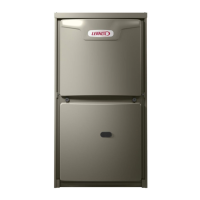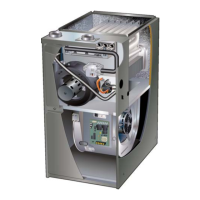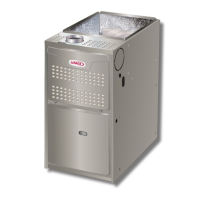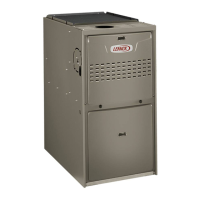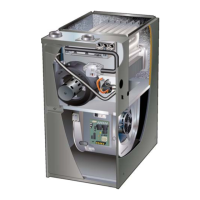Page 44
IV-HEATING SYSTEM SERVICE CHECKS
A-CSA Certication
All units are CSA design certied without modications.
Refer to the ML296DFV(X) Installation Instruction.
B-Gas Piping
CAUTION
If a exible gas connector is required or allowed by
the authority that has jurisdiction, black iron pipe
shall be installed at the gas valve and extend outside
the furnace cabinet. The exible connector can then
be added between the black iron pipe and the gas
supply line.
WARNING
Do not over torque (800 in-lbs) or under torque (350
in-lbs) when attaching the gas piping to the gas
valve.
Gas supply piping should not allow more than 0.5”W.C.
drop in pressure between gas meter and unit. Supply gas
pipe must not be smaller than unit gas connection.
Compounds used on gas piping threaded joints should be
resistant to action of liqueed petroleum gases.
C-Testing Gas Piping
IMPORTANT
In case emergency shutdown is required, turn o the
main shut-o valve and disconnect the main power
to unit. These controls should be properly labeled
by the installer.
When pressure testing gas lines, the gas valve must be
disconnected and isolated. Gas valves can be damaged if
subjected to more than 0.5 psig (14” W.C.). See FIGURE
51. If the pressure is greater than 0.5psig (14”W.C.), use
the manual shut-o valve before pressure testing to iso-
late furnace from gas supply.
VALVE WILL NOT HOLD
NORMAL TEST PRESSURE
CAP
FURNACE
ISOLATE
GAS VALVE
1/8” N.P. T. PLUGGED TAP
FIGURE 51
When checking piping connections for gas leaks, use
preferred means. Kitchen detergents can cause harmful
corrosion on various metals used in gas piping. Use of
a specialty Gas Leak Detector is strongly recommended.
It is available through Lennox under part number 31B2001.
See Corp. 8411-L10, for further details.
Do not use matches, candles, ame or any other
source of ignition to check for gas leaks.
D-Testing Gas Supply Pressure
An inlet pressure post located on the gas valve provides
access to the supply pressure. See FIGURE 50. Back out
the 3/32 hex screw one turn, connect a piece of 5/16 tub-
ing and connect to a manometer to measure supply pres-
sure. See table 21 for supply line pressure.
E-Check Manifold Pressure
NOTE - Pressure test adapter kit (10L34) is available from
Lennox to facilitate manifold pressure measurement.
A manifold pressure post located on the gas valve pro-
vides access to the manifold pressure. See FIGURE 50.
Back out the 3/32 hex screw one turn, connect a piece
of 5/16 tubing and connect to a manometer to measure
manifold pressure. To correctly measure manifold pres-
sure, the dierential pressure between the positive gas
manifold and the negative burner box must be considered.
IMPORTANT
For safety, connect a shut-o valve between the
manometer and the gas tap to permit shut o of gas
pressure to the manometer.
1 - Connect the test gauge positive side “+“ to manifold
pressure tap on gas valve as noted above.
2 - Tee into the gas valve regulator vent hose and
connect to test gauge negative “-”.
3 - Ignite unit on low re and let run for 5 minutes to
allow for steady state conditions.
4 - After allowing unit to stabilize for 5 minutes, record
low re manifold pressure and compare to value
given in TABLE 21. If necessary, make adjustment.
FIGURE 50 shows location of low re adjustment
screw.
5 - Repeat on high re and compare to value given in
TABLE 21. If necessary, make adjustment. FIGURE
50 shows location of high re adjustment screw.
6 - Shut unit o and remove manometer as soon as an
accurate reading has been obtained.
7 - Start unit and perform leak check. Seal leaks if
found.
The gas valve is factory set and should not require adjust-
ment. All gas valves are factory regulated.
F- Proper Gas Flow (Approximate)
Furnace should operate at least 5 minutes before check-
ing gas ow. Determine time in seconds for two revolu-
tions of gas through the meter. (Two revolutions assures
a more accurate time.) Divide by two and compare to
time in TABLE 18. If manifold pressure matches TABLE
21 and rate is incorrect, check gas orices for proper size
and restriction.
